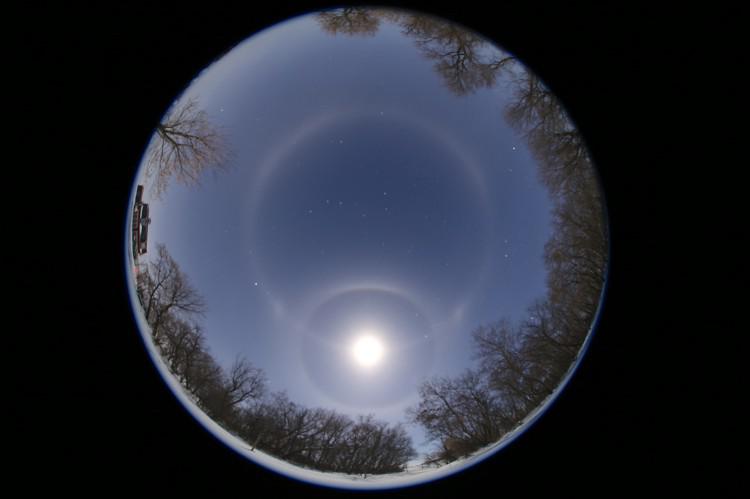This page describes an image Selene meets the Moon, by Sheila Wiwchar, Canada
Image caption:
First place in the 2021 IAU OAE Astrophotography Contest, category Sun/Moon haloes.
Photographed at Kaleida, Manitoba in Canada, this fisheye image beautifully captures the rare optical phenomena encircling the moon known as the “22° halo” and the horizontal white circle passing through the moon called the “paraselenic circle”. The white band circling the whole sky at the same altitude as the moon is named after Selene, the ancient Greek Titan, famously called the goddess of the moon. The more commonly observed counterpart produced by the sun is known as the parhelic circle, named after the Greek god of the sun, Helios. Both the 22° halo and the paraselenic circle are produced due to reflection of the moonlight from near vertical surfaces of ice crystals. Parts closer to the moon are caused due to external reflections, whereas those further away are created due to internal reflections. The constellation of the big dipper at the center makes this image even more spectacular. Can you spot it?
Scroll to captions in other languages
Image credit:
Sheila Wiwchar/IAU OAE
DOI: 10.5281/zenodo.5418731
Related glossary terms:
Halo
, Moon
Categories:
Naked Eye Astronomy
Image license: Creative Commons Attribution 4.0 International (CC BY 4.0) Creative Commons Attribution 4.0 International (CC BY 4.0) icons
The media file captions presented on the OAE website were written, translated and reviewed by a collective effort from the OAE, the OAE Centers and Nodes, the OAE National Astronomy Education Coordinators (NAECs) and other volunteers. You can find a full list of credits for our translation project here. All media file captions are released under a Creative Commons CC BY-4.0 license and should be credited to "IAU OAE". The media files themselves may have different licenses (see above) and should be credited as listed above under "credit".
If you notice a factual error in this caption or an error in any of its translations then please get in touch.
Captions in Different Languages:
Image caption: Primo posto al concorso di astrofotografia IAU OAE 2021, categoria Aloni di Sole/Luna.
Fotografata a Kaleida, Manitoba in Canada, questa immagine fisheye cattura magnificamente il raro fenomeno ottico che circonda la luna noto come "alone a 22°" e il cerchio bianco orizzontale che attraversa la luna chiamato "cerchio paraselenico". La fascia bianca che circonda l'intero cielo alla stessa altitudine della luna prende il nome da Selene, l'antico Titano greco, notoriamente chiamato la dea della luna. La controparte più comunemente osservata prodotta dal sole è nota come cerchio paraselenico, dal nome del dio greco del sole, Helios. Sia l'alone di 22° che il cerchio paraselenico sono prodotti dalla riflessione della luce lunare da superfici quasi verticali di cristalli di ghiaccio. Le parti più vicine alla luna sono causate da riflessioni esterne, mentre quelle più lontane sono create da riflessioni interne. La costellazione dell'Orsa Maggiore al centro rende questa immagine ancora più spettacolare. Riuscite a individuarla?
Image credit: Sheila Wiwchar/IAU OAE
Related glossary terms: L'alone , Luna Caption translation status: Approved by a reviewer
Caption translators: Giuliana Giobbi, Francesco Salvestrini
Caption reviewers: Rosa Valiante, Rodolfo Canestrari
Image caption: 2021 年国际天文学联合会 OAE 天体摄影比赛日/月晕类第一名。
这幅精美的鱼眼照片拍摄于加拿大曼尼托巴省的卡莱伊达(Kaleida),捕捉到了环绕月亮的罕见光学现象,即 "22°晕 ",和穿过月亮的水平白圈,即 "幻月环"。与月亮在同一高度环绕整个天空的白色光带是以古希腊提坦女神塞勒涅的名字命名的,她被称为月亮女神。由太阳产生的对应现象更常被观测到,称为 "幻日环"(parhelic circle),以希腊太阳神赫利俄斯的名字命名。22° 晕和幻月环都是由于月光从近乎垂直的冰晶表面反射而产生的。离月球较近的部分是由于外部反射造成的,而离月球较远的部分则是内部反射造成的。位于中心的北斗七星让这幅图像更加壮观。你能发现它吗?
Image credit: Sheila Wiwchar/IAU OAE
Related glossary terms: 晕 , 月球 Caption translation status: Not yet approved by a reviewer
Caption translators: Hu Xueying
Image caption: 2021 年國際天文學聯合會 OAE 天體攝影比賽日/月暈類第一名。
這幅精美的魚眼照片拍攝於加拿大曼尼托巴省的卡萊伊達(Kaleida),捕捉到了環繞月亮的罕見光學現象,即 "22°暈 ",和穿過月亮的水平白圈,即 "幻月環"。與月亮在同一高度環繞整個天空的白色光帶是以古希臘提坦女神塞勒涅的名字命名的,她被稱為月亮女神。由太陽產生的對應現象更常被觀測到,稱為 "幻日環"(parhelic circle),以希臘太陽神赫利俄斯的名字命名。22° 暈和幻月環都是由於月光從近乎垂直的冰晶表面反射而產生的。離月球較近的部分是由於外部反射造成的,而離月球較遠的部分則是內部反射造成的。位於中心的北斗七星讓這幅圖像更加壯觀。你能發現它嗎?
Image credit: Sheila Wiwchar/IAU OAE
Related glossary terms: 暈 , 月球 Caption translation status: Not yet approved by a reviewer
Caption translators: An automated transliteration from the simplified Chinese translation by - Hu Xueying









